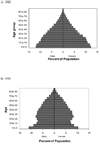The Epidemiologic Transition: Changing Patterns of Mortality and Population Dynamics
- PMID: 20161566
- PMCID: PMC2805833
- DOI: 10.1177/1559827609335350
The Epidemiologic Transition: Changing Patterns of Mortality and Population Dynamics
Abstract
The epidemiologic transition describes changing patterns of population age distributions, mortality, fertility, life expectancy, and causes of death. A number of critiques of the theory have revealed limitations, including an insufficient account of the role of poverty in determining disease risk and mortality, a failure to distinguish adequately the risk of dying from a given cause or set of causes from the relative contributions of various causes of death to overall mortality, and oversimplification of the transition patterns, which do not fit neatly into either historical periods or geographic locations. Recent developments in epidemiologic methods reveal other limitations. A life course perspective prompts examination of changes in causal pathways across the life span when considering shifts in the age distribution of a population as described by the epidemiologic transition theory. The ecological model assumes multiple levels of determinants acting in complex and interrelated ways, with higher level determinants exhibiting emergent properties. Development, testing, and implementation of innovative approaches to reduce the risks associated with the sedentary lifestyle and hyper nutrition in developed countries should not overshadow the continuing threat from infectious diseases, especially resistant strains or newly encountered agents. Interventions must fit populations and the threats to health they experience, while anticipating changes that will emerge with success in some areas. This will require new ways of thinking that go beyond the epidemiologic transition theory.
Figures





Similar articles
-
Burden of disease scenarios for 204 countries and territories, 2022-2050: a forecasting analysis for the Global Burden of Disease Study 2021.Lancet. 2024 May 18;403(10440):2204-2256. doi: 10.1016/S0140-6736(24)00685-8. Lancet. 2024. PMID: 38762325 Free PMC article.
-
Forecasting life expectancy, years of life lost, and all-cause and cause-specific mortality for 250 causes of death: reference and alternative scenarios for 2016-40 for 195 countries and territories.Lancet. 2018 Nov 10;392(10159):2052-2090. doi: 10.1016/S0140-6736(18)31694-5. Epub 2018 Oct 16. Lancet. 2018. PMID: 30340847 Free PMC article.
-
The global impact of noncommunicable diseases: estimates and projections.World Health Stat Q. 1988;41(3-4):255-66. World Health Stat Q. 1988. PMID: 3232413
-
The Minderoo-Monaco Commission on Plastics and Human Health.Ann Glob Health. 2023 Mar 21;89(1):23. doi: 10.5334/aogh.4056. eCollection 2023. Ann Glob Health. 2023. PMID: 36969097 Free PMC article. Review.
-
Tuberculosis.In: Holmes KK, Bertozzi S, Bloom BR, Jha P, editors. Major Infectious Diseases. 3rd edition. Washington (DC): The International Bank for Reconstruction and Development / The World Bank; 2017 Nov 3. Chapter 11. In: Holmes KK, Bertozzi S, Bloom BR, Jha P, editors. Major Infectious Diseases. 3rd edition. Washington (DC): The International Bank for Reconstruction and Development / The World Bank; 2017 Nov 3. Chapter 11. PMID: 30212088 Free Books & Documents. Review.
Cited by
-
Iranian experts' perspectives on facilitators and barriers influencing the infectious disease knowledge network: A qualitative study.BMC Health Serv Res. 2024 Sep 7;24(1):1040. doi: 10.1186/s12913-024-11525-8. BMC Health Serv Res. 2024. PMID: 39244579 Free PMC article.
-
Best Practices in the Management of Clostridioides difficile Infection in Developing Nations.Trop Med Infect Dis. 2024 Aug 19;9(8):185. doi: 10.3390/tropicalmed9080185. Trop Med Infect Dis. 2024. PMID: 39195623 Free PMC article. Review.
-
Nutrition transition profiles and obesity burden in Argentina.Public Health Nutr. 2019 Aug;22(12):2237-2247. doi: 10.1017/S1368980019000429. Epub 2019 Mar 12. Public Health Nutr. 2019. PMID: 30859931 Free PMC article.
-
Association of Socioeconomic Position and Demographic Characteristics with Cardiovascular Disease Risk Factors and Healthcare Access among Adults Living in Pohnpei, Federated States of Micronesia.Int J Chronic Dis. 2014;2014:595678. doi: 10.1155/2014/595678. Epub 2014 Dec 22. Int J Chronic Dis. 2014. PMID: 26464859 Free PMC article.
-
Global Burden of Disease and the Impact of Mental and Addictive Disorders.Curr Psychiatry Rep. 2019 Feb 7;21(2):10. doi: 10.1007/s11920-019-0997-0. Curr Psychiatry Rep. 2019. PMID: 30729322 Review.
References
-
- Omran AR. The Epidemiologic Transition. Milbank Mem Fund Q. 1971;49:509–538. - PubMed
-
- Armelagos GJ, Brown PJ, Turner B. Evolutionary, historical and political economic perspectives on health and disease. Soc Sci Med. 2005;61:755–765. - PubMed
-
- The Future of Public Health. Washington, DC: National Academy Press; 1988. Institute of Medicine, Committee for the Study of the Future of Public Health.
-
- Susser M. Epidemiology in the United States after World War II: The Revolution of Technique. Epidemiologic Reviews. 1985;7:147–177. - PubMed
Grants and funding
LinkOut - more resources
Full Text Sources
